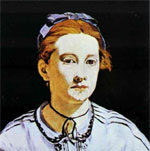But judging the groupie dynamic by scenes like this is as misguided as saying, for instance, that San Francisco is a city of ugly buildings because there are a lot of funky McDonald’s fast food restaurants there. The (so to speak) architecture of the groupie landscape is a panorama of skyscrapers and cottages, elegant spires and sprawling campuses, glass and steel, bricks and wood, an inspiring vista in all directions. And, unlike the self-similar fractal trivialities of the Mandelbrot set, where ever you look at the groupie landscape what you see is always uniquely beautiful, interesting and cool, never repeated regardless of what dimension you move your point-of-view through.
Music is less visual than painting, but the painting world participates in the same groupie dynamic as the music world. Here are some views—visual and textual—of part of the landscape. Quotes and images from Eyewitness Art: Manet.
Isn’t it odd that the writer said Meurent “disappeared into oblivion” when, today, her face and body—and thanks to the skill of Manet, the object of her attention, something of her character and spirit—are viewed and admired, experienced, by thousands of people every day in museums around the world, in books around the world, on the internet around the world?
That’s a strange kind of oblivion.
It’s a timeless oblivion. A magical oblivion. It is an oblivion that is bright and warm under the strange sun of Magonia, a sun that illuminates a very interesting landscape. A wonderful landscape.
*
Get well soon, Marianne Faithfull!



No comments:
Post a Comment